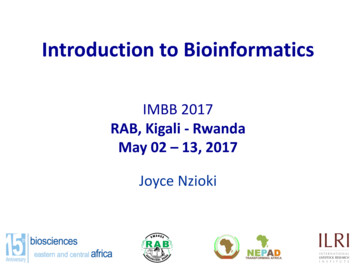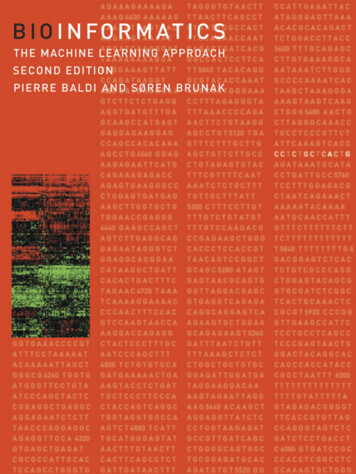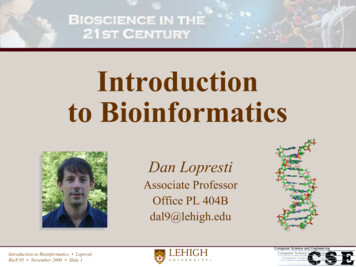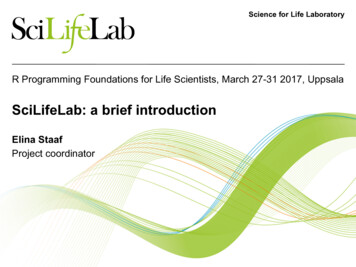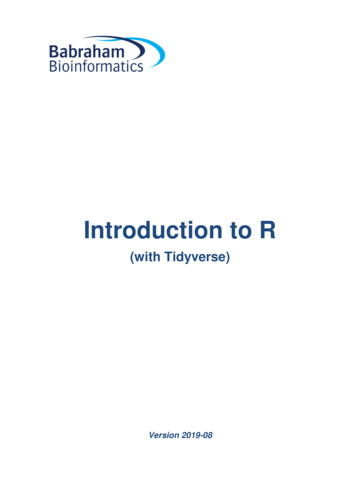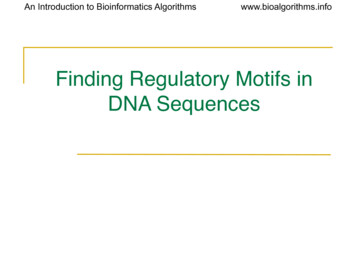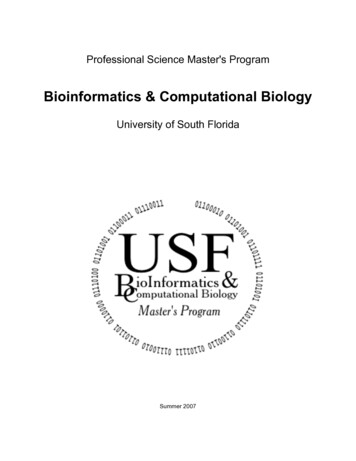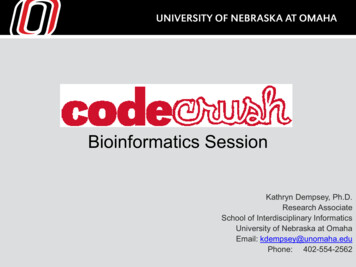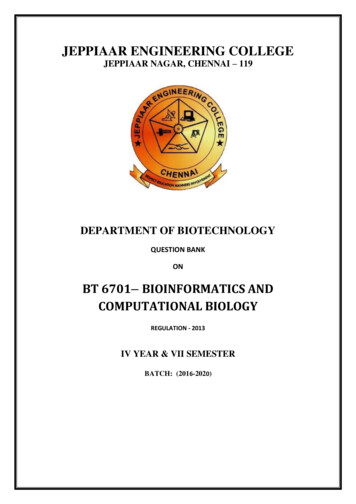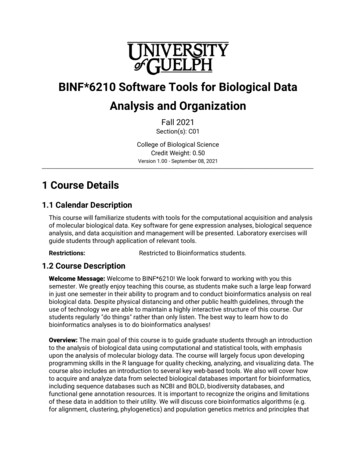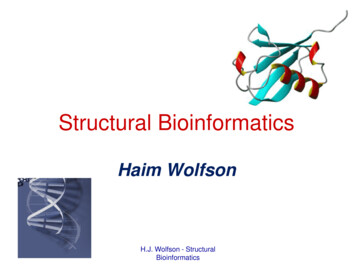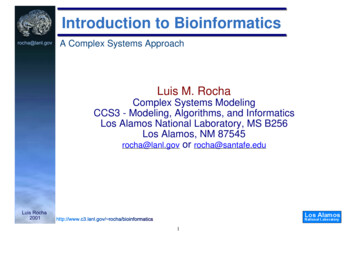
Transcription
Introduction to BioinformaticsA Complex Systems ApproachLuis M. RochaComplex Systems ModelingCCS3 - Modeling, Algorithms, and InformaticsLos Alamos National Laboratory, MS B256Los Alamos, NM 87545rocha@lanl.gov or rocha@santafe.edu1
Bioinformatics: A Complex Systems ApproachCourse Layout! Monday: Overview and BackgroundLuis Rocha! Tuesday: Gene Expression Arrays – Biology andDatabasesTom Brettin! Wednesday: Data Mining and Machine LearningLuis Rocha and Deborah Stungis Rocha! Thursday: Gene Network InferencePatrik D'haeseleer! Friday: Database Technology, InformationRetrieval and Distributed Knowledge SystemsLuis Rocha2
Bioinformatics: A Complex Systems ApproachOverview and Background! A Synthetic Approach to BiologyInformation Processes in Biology– BiosemioticsGenome, DNA, RNA, Protein, and Proteome– Information and Semiotics of the Genetic SystemComplexity of Real Information Proceses– RNA Editing and Post-Transcription changesReductionism, Synthesis and Grand ChallengesTechnology of Post-genome informatics– Sequence Analysis: dynamic programming, simulatedanealing, genetic algorithmsArtificial Life3
Information Processes in BiologyDistinguishes Life from Non-LifeDifferent Information Processing Systems (memory)! Genetic SystemConstruction (expression, development, and maintenance) of cellsontogenetically: horizontal transmissionHeredity (reproduction) of cells and phenotypes: verticaltransmission! Immune SystemInternal response based on accumulated experience (information)! Nervous and Neurological systemResponse to external cues based on memory! Language, Social, Ecological, Eco-social, etc.4
What is Information?Choice, alternative, memory, semiosis.PragmaticEvolution, ValueIs the function useful in context?Function, useSemanticOne is used to construct a functionalprotein, the other contains junkInformationStructural(Syntactic)Alternatives, possibility2 DNA molecules with same lengthstore the same amount of informationInformationTheoryFor Discrete Memory Structures !!What does information mean in continuous domains?5
Biology and BiosemioticsThe Study of the Semiosis of LifeBiology is the science of life that aims atunderstanding the structural, functional, andevolutionary aspects of living organismsBiosemiotics is the study of informationalaspects of biology in their syntactic,semantic, and pragmatic dimensions.Genomics research has focused mostly on thesyntactic (structural) dimension. Bioinformatics is animportant tool for a more complete Biosemiotics6
Genomics and ProteomicsInformation and Expression Units! Mendelian GeneHereditary unit responsible for a particular characteristic or trait! Molecular Biology GeneUnit of (structural and functional) information expression (viaTranscription and Translation)! GenomeSet of genes in the chromosome of a speciesUnit of (structural) information transmission (via DNA replication)! GenotypeInstance of the genome for an individual! PhenotypeExpressed and developed genotype! Proteome(Dynamic) Set of proteins that are encoded and expressed by agenome7
Nucleic Acids as Information StoresNucleotides (bases) as linguistic symbolsComplementary base pairingPurine (R)NucleotidesPyrimidine (Y)4 Letter AlphabetDNA: A, G, C, TRNA: A, G, C, UForm sequencesthat can storeinformationAdenine (A) (Hydrogen-bonding betweenpurines and pyrimidines)Guanine (G)G-CCytosine (C) A-T (U)Thymine (T)Uracil (U)Linear molecules with aphosphate-sugarbackbone (deoxyriboseand ribose)Requirements for structural informationPossibility of repeated copying8
Information and Sequence Space24648For a sequence oflength n, composedof m-ary symbols, mnpossible values(structures) can bestored169
Proteins: Functional ProductsSequences of Amino acids via peptide bondsPolypeptide chains of aminoacidsPrimary StructureFolding3-dimensional structureSecondary and tertiary bonds! In proteins, it is the 3dimensional structurethat dictates functionThe specificity ofenzymes to recognizeand react onsubstrates! The functioning of thecell is mostlyperformed by proteinsThough there are alsoribozymes10
! The genetic codemaps informationstored in thegenome intofunctional proteinsThe Genetic CodeTriplet combinationsof nucleotides intoamino acidsTriplets of 4 Nucleotidescan define 64 possiblecodons, but only 20amino acids are used(redundancy)11
The geneticcode at workStructural andFunctional Information! ReproductionDNA Polymerase! TranscriptionRNA Polymerase! TranslationRibosome! Coupling of AA’s toadaptorsAminoacyl Synthetase12
Variationsof GeneticCodes13
The Semiotics of the Genetic SystemThe Central Dogma of Information TransmissionSyntactic relations (structure)Genotype ino Acid ChainsDevelopmentA code mediates between rateindependent and rate-dependentdomains. The components ofthe first are effectively inert andused as memory stores(structural information,descriptions, etc.) While thecomponents of the second aredynamic (functional) playersused to directly act in the world(e.g. enzymes). etic information is not expressed by the dynamics ofnucleotide sequences (RNA or DNA molecules), but isinstead mediated through an arbitrary coding relation thattranslates nucleotide sequences into amino-acid sequenceswhose dynamic characteristics ultimately express geneticinformation in an environment.” sa2.html.14
Real Information Processes in TheGenetic SystemA More Complex Picture of Syntactic Operations! Reverse-TranscriptionRetroviruses store genetic information in genomic RNA rather thanDNA, so to reproduce they require reverse transcription into DNAbefore replication! Complex Transcription of DNA to RNA before translationIntron Removal and Exon Splicing (deletion operation)RNA Editing (insertion and replacement operation)! Do not challenge the Central Dogma but increase thecomplexity of information onAmino Acid Chains15
RNA n Glu Gly Arg Gly Lys .CAGGAGGGCCGUGGAuAAG .Gln Glu Gly Arg Gly STOP16
RNA Editing acts on Memory (syntax)Genetic Code NARNA Editing System17DNARNA Editing System
RNA Editing as a Measurement CodeExpanding the Semiotics of the Genetic SystemA Richer Computationalprocess with EvolutionaryAdvantagesSyntactic relationsGenotype TranscriptionDNARNACodeAmino Acid ns! Suggested Process of Control ofDevelopment Processes fromenvironmental cuesIn Trypanosomes : Benne, 1993; Stuart,1993. Evolution of parasites: Simpsonand Maslov, 1994. Neural receptorchannels in rats: Lomeli et al, 1994Metal ion switch (with ligase andcleavage activities) in a single RNAmolecule used to modulate biochemicalactivity from environmental cues.Landweber and Pokrovskaya, 199918MeasurementActionises.html and e95 abs.html
Post-TranslationComplex Dynamic Interactions! Rate-dependent expression products: non-linear,environmentally dependent, developmentCatalysis, metabolism, cell regulation! Protein folding though thermodynamically reversible in-vitro,is expected to depend on complex cellular processesE.g. chaperone molecules! Prediction of protein folded structure and function fromsequence is hard! Biological function is not known for roughly half of the genesin every genome that has been sequencedLack of technologyThe genome itself does not contain all information about expressionand development (Contextual Information Processing)19
BioinformaticsA Synthetic Multi-Disciplinary Approach to Biology! Genome Informatics initially as enabling technology for thegenome projectsSupport for experimental projectsGenome projects as the ultimate reductionism: search andcharacterization of the function of information building blocks (genes)Deals with syntactic information alone! Post-genome informatics aims at the synthesis of biologicalknowledge (full semiosis) from genomic informationTowards an understanding of basic principles of life (while developingbiomedical applications) via the search and characterization ofnetworks of building blocks (genes and molecules)– The genome contains (syntactic) information about building blocks but it ispremature to assume that it also contains the information on how thebuilding blocks relate, develop, and evolve (semantic and pragmaticinformation)Interdisciplinary: biology, computer science, mathematics, and physics20
Bioinformatics as BiosemioticsA Synthetic Multi-Disciplinary Approach to Biology! Not just support technology but involvement in the systematic design andanalysis of experimentsFunctional genomics: analysis of gene expression patterns at the mRNA(syntactic information) and protein (semantic information) levels, as well asanalysis of polymorphism, mutation patterns and evolutionary considerations(pragmatic information).– Using and developing computer science and mathematicsWhere, when, how, and why of gene expressionPost-genome informatics aims to understand biology at the molecular networklevel using all sources of data: sequence, expression, diversity, etc.Cybernetics, Systems Theory, Complex Systems approach to Theoretical Biology! Grand Challenge: Given a complete genome sequence, reconstruct in acomputer the functioning of a biological organismRegards Genome more as set of initial conditions for a dynamic system, not ascomplete blueprint (Pattee, Rosen, Atlan). The genome can be contextuall anddynamically accessed and even modified by the complete network of reactions inthe cell (e.g. editing).Uses additional knowledge for comparative analysis: Comparative Biology– e.g. reference to known 3D structures for protein folding prediction, or referencedatabases across species21
Components of haDataCollectionMachineLearning22(Kepler)Rocha
Sequence AnalysisUncovering higher structural and functional characteristicsfrom nucleotide and amino acid sequencesData-Driven approach rather than first-principles equations.Assumption:when 2 molecules share similar sequences, they are likely toshare similar 3D structures and biological functions because ofevolutionary relationships and/or physico-chemical constraints.! Similarity (Homology) SearchPairwise and multiple sequence alignment, database search, phylogenetic treereconstruction, Protein 3D structure alignment– Dynamic programming, Simulated annealing, Genetic Algorithms, Neural Networks! Structure/function predictionAb initio: RNA secondary and 3D structure prediction, Protein 3D structurepredictionKnowledge-based: Motif extraction, functional site prediction, cellularlocalization prediction, coding region prediction, protein secondary and 3Dstructure prediction– Discriminant analysis, Neural Networks, Hidden Markov Model, Formal Grammars23
Similarity Search vs. Motif SearchData-driven vs. Knowledge-based Functional Interpretation! Similarity (Homology) SearchA query sequence is compared with others in database. If a similarsequence is found, and if it is responsible for a specific function, thenthe query sequence can potentially have a similar function.– Like assuming that similar phrases in a language mean the same thing.! Motif Search (Knowledge-based)A query sequence is compared to a motif library, if a motif is present,it is an indication of a functional site.– A Motif is a subsequence known to be responsible for a particular function(interaction sites with other molecules)– A Motif library is like a dictionary– Unfortunately there are no comprehensive motif libarries for all types offunctional properties24
Similarity Search vs. Motif Search25
Sequence Similarity SearchSequence Alignment! Produce the optimal (global or local) alignment that bestreveals the similarity between 2 sequences.Minimizing gaps, insertions, and deletions while maximizingmatches between elements.An emprirical measure of similarity between pairs of elements isneeded (substitution scoring scheme)– Such as the amino acid mutation matrixDayhoff et al [1978] collected data for accepted point mutations (frequencyof mutation) (PAMs) from groups of closely related proteins. Differentmatrices reflect different properties of amino acids (e.g. volume andhydrophobicity)AAIndex: www.genome.ad.jp/dbget/aaindex.html26
Mutation Matrix as Substitution Table27
Dynamic ProgrammingFor Sequence Alignment OptimizationOptimal alignment maximizing thenumber of matched lettersScore function: 1 for match, 0 formismatch, 0 for insertion/deletion3 matches, 2 mismatches, 2 gap insertions 3AIMSAMOSAIM-SA-MOSDynamic programming is a very general optimization technique forproblems that can recursively be divided into two similar problems ofsmaller size, such that the solution to the larger problem can be obtainedby piecing together the solutions to the two subproblems. Example:shortest path between 2 nodes in a graph.28
Dynamic ProgrammingPath MatrixAlign a letter fromhorizontal with gap(inserted) in verticalLeft-rightA path starting at the upper-left corner and ending at the lower-right corner of thepath matrix is a global alignment of the two sequences. The optimal alignment isthe optimal path in the matrix according to the score function for each of the 3path alternatives at each node. Most path branches are pruned out locallyaccording to the score function.29
Global Sequence AlignmentWith Dynamic Programming! Score Function D (to optimize) sum of weights at eachalignment position from a substitution matrix WNucleotide sequences– Arbitrary weights: a fixed value for a match or mismatch irrespectiveof the types of base pairsAmino acid sequences– Needs to reveal the subtle sequence similarity. Substitution matrixconstructed from the amino acid mutation frequency adjusted fordifferent degrees of evolutionary divergence (since the table is built forclosely related sequences)Weigth for aligning (Substituting ) element i from sequence s withWs(i),t(j) elementj of sequence td Weigth for a single element gapDi,j max(Di-1,j-1 Ws(i),t(j), Di-1,j d, Di,j-1 d)D0,0 0, Di,0 id (i 1.n), D0,j jd (j 1.m)30
Global AlignmentDi,j max(Di-1,j-1 Ws(i),t(j), Di-1,j d, Di,j-1 d)D0,0 0, Di,0 id (i 1.n), D0,j jd (j 1.m)Starting at D1,1, repeatedlyapplying the formula, thefinal Dn,mis the optimal value of the scorefunction for the alignment. Theoptimal path is reconstructed fromthe stored values of matrix D bytracing back the highest localvaluesNumber of operationsproportional to the sizeof the matrix n m : O (n2)Needleman and Wunsch algorithm introduces a gaplength dependence with a gap opening andelongation penalty.31
Local AlignmentAlignment of subsequencesDi,j max(Di-1,j-1 Ws(i),t(j), Di-1,j d, Di,j-1 d)D0,0 0, Di,0 id (i 1.n), D0,j jd (j 1.m)D0,j 0 (j 1.m) Any letter in the horizontal sequence can be a startingpoint without any penalty: detects multiple matcheswithin the horizontal sequence containing multiplesubsequences similar to the vertical sequence32
Local AlignmentSmith-Waterman Local Optimality AlgorithmDi,j max(Di-1,j-1 Ws(i),t(j), Di-1,j d, Di,j-1 d)D0,0 0, Di,0 id (i 1.n), D0,j jd (j 1.m)Di,j max(Di-1,j-1 Ws(i),t(j), Di-1,j d, Di,j-1 d, 0)Ws(i),t(j) 0 matchWs(i),t(j) 0 mismatchd 0Forces local score to be non-negative. Optimal path isnot entered, but clusters of favourable local alignmentregions. Trace back starts at the matrix element withmaximum score.33
Similarity Database SearchParallelized Dynamic ProgrammingNumber of operations in DP is proportional to the size of thematrix n m: O(n2)ParallelSequential34
FASTA MethodDot Matrix Reduces DP Search AreaAIMSA*M*OS*Dot MatrixThe dot matrix can be used to recognize local alignments which show as diagonalstretches or clusters of diagonal strectches. DP can be used only for the portionsof the matrix around these clusters – a limited search area.35
FASTAHashing the Dot MatrixRapid access to stored data items by hashing. Sequences are stored as hash(look-up) tables. This facilitates the sequence comparison to produce a dotmatrix. 4 times faster for nucleotide sequences: the number of operations isproportional to to the mean row size of the hash table (times dots are entered),which is on averahe 1/4 of the sequence.36
Statistical SignificanceIs the similarity found biologically significant?Because good alignments can occur by chance alone, the statistics of alignmentscores help assess the significance. We know that the average alignment scorefor a query sequence with fixed length n increases with the logarithm of length mof a database sequence. Thus, the distribution of sequence lengths in thedatabase can be used to estimate empirically the value of the expected frequencyof observing an alignment with high score.Another idea is to use the Z-test:S µZ σS is the optimal alignment between 2 sequencesEach sequence is randomized k times (preserving the composition) and new optimalalignment is computed: s1, s2, ., sk with mean and standard deviation ) . If thescore distribution is normal, Z values of 4 and 5 correspond to threshold probabilitiesof 3 10-5 and 3 10 -6. However, the distribution typically decays exponentially in Srather than S 2 (as in the normal distribution). Thus, a higher Z value should betaken as a threshold for significant similarity.37
Multiple AlignmentSimultaneous Comparison of a Group of Sequences! DP can be expanded to a n-dimensional search space.Exhaustive search is manageable for 3, and for a limited portion of thespace for up to 7 or 8 sequences.! Heuristics and approximate algorithmsCompute score for sequences A-C, from A-B, and B-C – which is ingeneral different from the optimal A-C.Hierarchical Clustering of a set of sequences, followed by computation ofthe alignment between groups of sequences without changing thepredetermined alignment within each group.38
Simulated AnnealingFor Multiple Alignment! SA is a stochastic method to search for globalE(-S)xminimum in the optimization of functions to beminimized.Starting with a given alignment for a set ofsequences, a small random modification isrepeatedly introduced and a new score iscalculated. When the score is better (negativeenergy function), it is accepted.Would Not escape local minima! A stochastic unfavourable modification is acceptedwith (Metropolis Monte Carlo) probability:E is the increment of the energy function from themodification. T is a simulated temperature parameter. Theprobability is calculated until equilibrium is reached. Thenthe temperature is lowered, and so on.! Global miniumum is guaranteed for infinite MMC steps andinfinitesimal T.Success depends onTi, Tf, T, and # of MMC steps39p e ( E / T )
Genetic AlgorithmsFor Multiple Sequence Alignment! GAs are another stochastic methodTraditional Genetic AlgorithmGenotypeS1S2 Snpused for optimization.Solutions to a problem are encodedin bit strings.The best decoded solutions areselected for the next population(e.g. by roulette wheel or Elite)Variation is applied to selected newpopulation (crossover peUsed for optimization of solutions fordifferent problems. Uses the syntacticoperators of crossover and mutation forvariation of encoded solutions, whileselecting best solutions from generationto generation. Holland, 1975; Goldberg,1989; Mitchell, 1995.40
Other Bioinformatics TechnologyMajor Components not Fully Discussed! BLASTHeuristic algorithm for sequence alignment thatincorporates good guesses based on theknowledge of how random sequences are related.! Prediction of structures and functionsNeural Networks and Hidden Markov Models41
Literature! Bioinformatics OverviewsKanehisa, M. [2000]. Post-Genome Informatics. Oxford University Press.Waterman, M.S. [1995] Introduction to Computational Biology . Chapman and Hall.Baldi. P. and S. Brunak [1998]. Bioinformatics: The Machine Learning Approach . MITPress.Wada, A. [2000]. “Bioinformatics – the necessity of the quest for ‘first principles’ in life”.Bioinformatics. V. 16, pp. tent/vol16/issue8 )! Dynamic Programming and Sequence AlignmentBertsekas, D. [1995]. Dynamic Programming and Optimal Control . Athena Scientific.Needleman, S. B. and Wunsch, C. D. [1970]. “A general method applicable to the searchfor similarities in the amino acid sequence of two proteins”. J. Mol. Biol., 48,443-53.Giegerich, R. [2000]. “A systematic approach to dynamic programming inbioinformatics”. Bioinformatics. V. 16, pp. 665-677.Sankoff, D. [1972]. Matching sequences under deletion/insertion constraints. Proc. Natl.Acad. Sci. USA, 69,4-6.Sellers, P. H [1974]. “On the theory and computation of evolutionary distances”. SIAM J.Appl. Mat ., 26,787-793.Sellers, P. H. [1980]. The theory and computation of evolutionary distances: patternrecognition. Algorithms, 1,359-73.Smith, T. F. and Waterman, M. S. [1981] . “Identification of common molecularsubsequences”. J.Mol. Biol., 147,195--7.Goad, W. B. and Kanehisa, M. I. [1982]. “Pattern recognition in nucleic acid sequences.I. A general method for finding local homologies and Symmetries”. Nucleic Acids Res.,10, 247-63.42
Literature! Similarity MatricesDayhoff, M. 0., Schwartz, R. M. and Orcutt, B.C. [1978] “A model of evolutionary changein proteins”. In Atlas of Protein Sequence and Structure , Vol. 5, Suppl. 3 (ed. M. 0.Dayhoff), pp. 345--52. National Biomedical Research Foundation, Washington, DC.Henikoff, S. and Henikoff, J. G. [1992]. Amino acid substitution matrices from proteinblocks. Proc. Natl.Acad. Sci. USA,89, 10915--19.! FASTA algorithm and BLAST algorithmWilbur, WJ. and Lipman, D.J. [1983]. Rapid similarity searches of nucleic acid andprotein data banks. Proc. Natl.Acad. sci. USA, 80,726-30.Lipman, D.J. and Pearson, W R. [1985]. Rapid and sensitive protein similarity searches.Science, 227,1435-41.Altschul, S. F., Gish, W, Miller, W, Myers, E. W, and Lipman, D.J. [1990]. Basic localalignment search tool. J. Mol. Biol., 215,403-10.Altschul, S. F., Madden, T. L., Schaeffer, A. A., Zhang, J., Zhang, Z., Miller, W, andLiprnan, D.J. [1997]. Gapped BLAST and PSI-BLAST:a new generacion of proteindatabase search programs. Nucleic Acids Res., 25, 3389--402.! Statistical SignificanceKarlin, S. and Altschul, S. F. [1990]. Methods for assessing the statiscical significance ofmolecular sequence features by using general scoring schemes. Proc. Natl. Acad. sci.USA, 87 . 2264-8.Pearson, W R. [1995]. Comparison of methods for searching protein sequecedatabases. Protein sci.,4, 1145--60.43
Literature! Simulated AnnealingIshikawa, M. et al [1993]. “Multiple sequence alignment by parallel simulated annealing.Compt. Appl. Biosci. 9, 267-73.Bertsimas, D. and J. Tsitsiklis [1993]. Simulated Annealing. Statis. Sci. 8, 10-15.Kirkpatrick, S. C.D. Gelatt, and M.O. Vecchi [1983]. Optimization by simulatedannealing. Science. 220, 671-680.! Genetic AlgorithmsGoldberg, D.E. [1989]. Genetic Algorithms in Search, Optimization, and MachineLearning. Addison-Wesley.Holland, J.H. [1975]. Adaptation in Natural and Artificial Systems . University of MichiganPress.Holland, J.H. [1995]. Hidden Order: How Adaptation Builds Complexity . AddisonWesley.Mitchell, Melanie [1996]. An Introduction to Genetic Algorithms . MIT Press.44
Literature! BiosemioticsEmmeche, Claus [1994]. The Garden in the Machine: The Emerging Science of ArtificialLife. Princeton University Press.Hoffmeyer, Jesper [2000]."Life and reference." Biosystems. In Press.Pattee, Howard H. [1982]."Cell psychology: an evolutionary approach to the symbolmatter problem." Cognition and Brain Theory . Vol. 5, no. 4, pp. 191-200.Rocha, Luis M. [1996]."Eigenbehavior and symbols." Systems Research. Vol. 13, No. 3,pp. 371-384.Rocha, Luis M. [2000]."Syntactic Autonomy: or why there is no autonomy withoutsymbols and how self-organizing systems might evolve them." In: Closure: EmergentOrganizations and Their Dynamics . J.L.R. Chandler and G. Van de Vijver (Eds.).Annals of the New York Academy of Sciences . Vol. 901, pp.207-223.http://www.c3.lanl.gov/ rocha/patteeRocha, Luis M. [2001]. “Evolution with material symbol systems”. Biosystems.45
Bioinformatics TechnologyGene Expression Focus! Biology Driver! Gene Expression Databases! Statistical and Machine Learning Analysis! Network Analysis and Modeling! Database Technology, Information Retrieval,and Recommendation46
Dynamic Programming For Sequence Alignment Optimization Optimal alignment maximizing the number of matched letters AIMS AMOS Score function: 1 for match, 0 for mismatch, 0 for insertion/deletion AIM-S A-MOS 3 matches, 2 mismatches, 2 gap insertions 3 Dynamic programm
